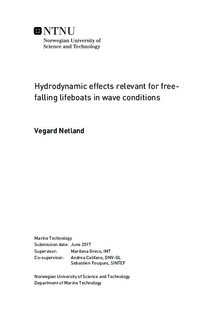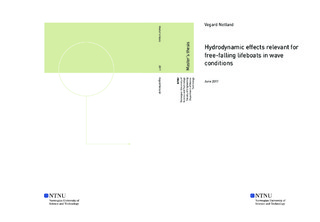| dc.description.abstract | A free- falling lifeboat is a last resort evacuation system, installed on many rigid and floating offshore structures. The diving process of a free-falling lifeboat is a complex matter, as the external forces varies through the process. The diving process is essentially divided into six different phases. These are the launching phase, free-falling phase, water entry phase, submerged phase, water exit phase and the sail away phase. The launching and free-falling phase determines the initial conditions at the point of impact, typically this will be impact velocity, water entry angle and angular rotations. As the body enters the water, it will be subjected to slamming forces. The pitch motion initially turns from clockwise to counter clockwise rotation, leading to larger slamming forces on the aft part. Eventually the aft part crosses the water surface and there will be an air cavity formation. The gravity will press the two newly formed free surfaces together and the unavoidable collapse leads to a large pressure on the body, in its direction of motion. This is due to the pressure from the water on the newly formed air bubble, entrapped on the very aft part. The body reaches its maximum submergence and then it starts the ascent phase, driven by the buoyancy. In the case of a positive surge motion and a counter clockwise rotation, the body will get this additional contribution in the ascent. The body eventually exits the water, where it gets a certain pop-up height, this height depends on the exit velocity and angle. As the body re-enters the water surface it can be subjected to a second slamming, and its magnitude is dependent on the pop-up height and the rotation after the water exit. It is favourable that the body sail as far as possible away from the evacuation scene. And this distance is dependent on the other phases.
A simplified free-falling lifeboat geometry were chosen for the simulations. The body is a semi-ellipsoid with length 10 m, and largest diameter 3 m. The simulations are run in the commercial software Star-CCM+. The simulations are computational expensive, and most of the simulations has been simulated on the high-performance computer, Vilje. A convergence check was preformed to investigate the quality of the solution and a suitable mesh size has been chosen with respect to satisfactory global behaviour and computational time.
A simulation has been preformed in calm water conditions. The result and behaviour of the body is reasonable compared to theory. The body is subjected to large deaccelerations and counter clockwise pitch accelerations in the water entry phase. The formation of an air cavity and its collapse is clearly visual in VOF-scenes and as a large peak in the body-fixed acceleration plot. The body exits bow first, gets some air time, and is subjected to a small second slamming as it re-enters the water surface.
A parameter investigation has been preformed where the impact velocity, water entry angle and centre of gravity in z-direction has been changed with ±5 m/s, ±5° and ±0.2 m, repectivly. The results showed that changing the velocity gave largest effect in the behaviour of the body, but the highest water entry angle gave the largest submergence which is an important parameter as it gives the highest hydrostatical pressure. Changing the centre of gravity showed to have relative small effects.
The lifeboat will most likely be used in a storm-conditions. Eighteen different cases has been simulated, with four different wave phases in three different headings. Three of these has been tested for two additional steepnesses. The waves are modelled as regular linear waves. The results shows that the behaviour of the body is greatly affected when waves are included in the simulation. The wave forces contribute in form of Froude-Krylov forces, diffraction forces and additional drag forces. Some of the largest accelerations in the water entry phase are found when the body dives in the wave phase where the fluid velocity is acting upwards. Large accelerations in the water entry phase are also observed when the fluid velocity is acting in the same global x- direction as the body. This creates a large counter clockwise pitch velocity which increases the slamming load on the aft part. The second slamming is dependent on the water exit, where the exit velocity, water exit angle, wave phase and heading are decisive.
The effect of decreasing the steepness was in general smaller accelerations in the water entry phase. The particle velocities are reduced as they are proportional to the wave amplitude. However, the second slamming is dependent on the water exit and the body rotation, and the CAR values shows that there can be large stresses on the passengers also in the case of small steepnesses.
Uncertainties connected with the simulations are the segregated flow and its weakness in term of predicting impulse forces like slamming, and how this manifests further in the solution. There has also been detected some unreal large velocities at the aft corner, leading to uncertainties on how these will affect the solution. Some errors in the interpolation between the cells in the overset mesh will be present as the overset mesh does not have a uniform cell size. | |

